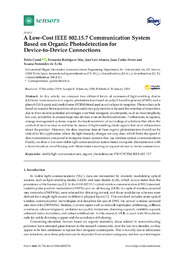Por favor, use este identificador para citar o enlazar este ítem:
https://hdl.handle.net/11000/35079Registro completo de metadatos
| Campo DC | Valor | Lengua/Idioma |
|---|---|---|
| dc.contributor.author | Corral González, Pablo | - |
| dc.contributor.author | Rodríguez Mas, Fernando | - |
| dc.contributor.author | Alonso, José Luis | - |
| dc.contributor.author | Ferrer, Juan Carlos | - |
| dc.contributor.author | Fernández de Ávila, Susana | - |
| dc.contributor.other | Departamentos de la UMH::Ingeniería de Comunicaciones | es_ES |
| dc.date.accessioned | 2025-01-21T09:33:20Z | - |
| dc.date.available | 2025-01-21T09:33:20Z | - |
| dc.date.created | 2020 | - |
| dc.identifier.citation | Sensors | es_ES |
| dc.identifier.issn | 1424-8220 | - |
| dc.identifier.uri | https://hdl.handle.net/11000/35079 | - |
| dc.description.abstract | In this article, we compare two different kinds of commercial light-emitting diodes (LEDs) in transmission and organic photodetectors based on poly(3-hexylthiophene) (P3HT) and a phenyl-C61-butyric acid methyl ester (PCBM) blend used as active layer in reception. Photovoltaic cells based on massive heterojunctions of semiconductor polymers have focused the attention of researchers due to their several potential advantages over their inorganic counterparts, such as their simplicity, low cost, and ability to process large area devices, even on flexible substrates. Furthermore, in logistics, storage management systems require the implementation of technological solutions that allow the control of merchandise in real time by means of light-emitting diode signals that send information about the product. However, the slow response time of these organic photodetectors should not be critical for this application, where the light intensity changes are very slow, which limits the speed of data transmission compared to inorganic based systems that use wireless optical communications. Finally, we show a low-cost visible light communication system based on organic photodetectors with a frame based on on-off keying with Manchester encoding to support device-to-device connections. | es_ES |
| dc.format | application/pdf | es_ES |
| dc.format.extent | 12 | es_ES |
| dc.language.iso | eng | es_ES |
| dc.publisher | MDPI | es_ES |
| dc.relation.ispartofseries | 20 | es_ES |
| dc.relation.ispartofseries | 3 | es_ES |
| dc.rights | info:eu-repo/semantics/openAccess | es_ES |
| dc.rights | Attribution-NonCommercial-NoDerivatives 4.0 Internacional | * |
| dc.rights.uri | http://creativecommons.org/licenses/by-nc-nd/4.0/ | * |
| dc.subject | visible light communications | es_ES |
| dc.subject | organic photodetector | es_ES |
| dc.subject | P3HT:PCBM | es_ES |
| dc.subject | IEEE 802.15.7 | es_ES |
| dc.subject.other | CDU::6 - Ciencias aplicadas::62 - Ingeniería. Tecnología | es_ES |
| dc.title | A Low-Cost IEEE 802.15.7 Communication System Based on Organic Photodetection for Device-to-Device Connections | es_ES |
| dc.type | info:eu-repo/semantics/article | es_ES |
| dc.relation.publisherversion | https://doi.org/10.3390/s20030714 | es_ES |

Ver/Abrir:
sensors-20-00714-v3.pdf
2,2 MB
Adobe PDF
Compartir:
 La licencia se describe como: Atribución-NonComercial-NoDerivada 4.0 Internacional.
La licencia se describe como: Atribución-NonComercial-NoDerivada 4.0 Internacional.
.png)